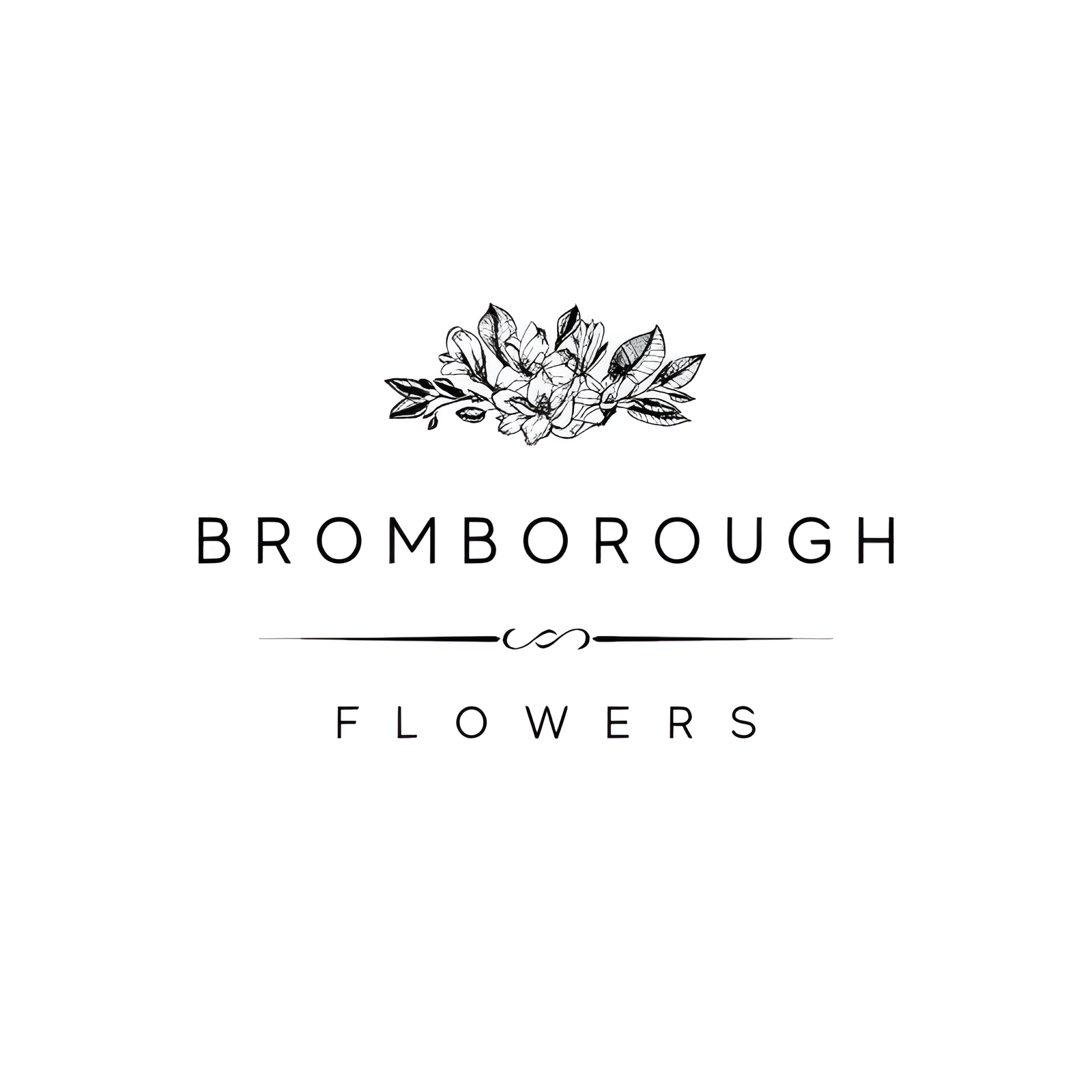When planning a wedding, selecting the perfect flowers can greatly enhance the ceremony’s ambiance, and hydrangeas are a top contender for many couples. Known for their voluminous clusters and diverse color palette, hydrangeas offer an exquisite mix of elegance and charm. Originating from Asia and celebrated in various cultures for their symbolism of gratitude and peace, these blooms present an array of options to match any wedding theme. As you consider the myriad of flower choices, the hydrangea’s unique attributes and cultural significance might just make them the ideal addition to your special day. Curious about how to incorporate them seamlessly?
Flower Overview
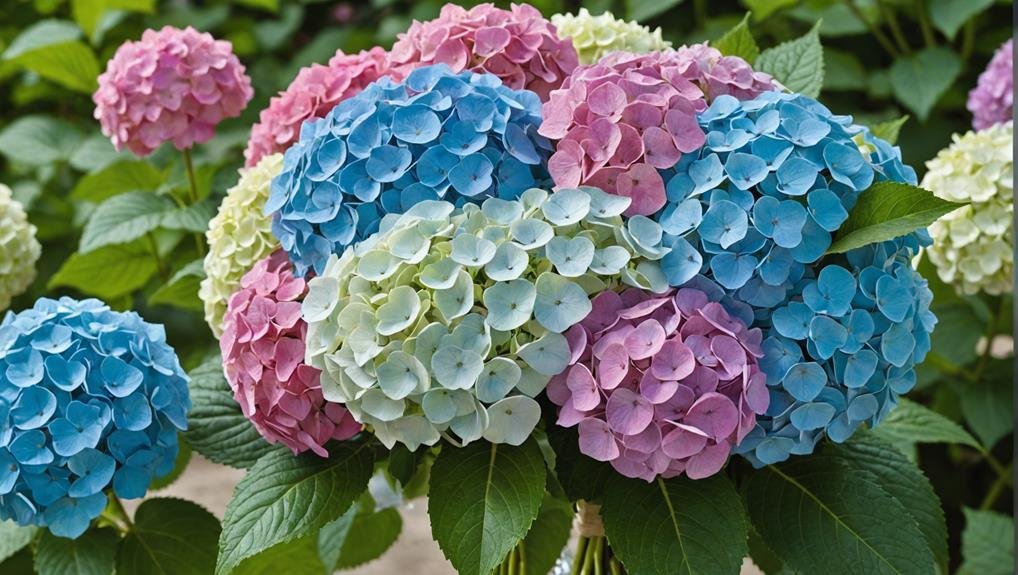
Hydrangeas are versatile flowers available in an array of colors, including pink, purple, blue, white, green, and red. This range of hues makes them an excellent choice for wedding bouquets, accommodating diverse color palettes and themes. The hydrangea’s ability to blend seamlessly into both classic and contemporary wedding designs adds to its popularity among brides and florists alike.
Each hydrangea stem features a cluster of tiny blooms that form a puff-like appearance, typically ranging from 4 to 8 inches in diameter. This characteristic makes them an ideal focal point in wedding bouquets, providing volume and a luxurious texture. Their lush, rounded clusters can serve as the main attraction in a bouquet or complement other floral elements, ensuring a harmonious and visually striking arrangement.
However, it is important to note that hydrangeas have a relatively short vase life. They require immediate hydration upon arrival and should be kept in cool temperatures to maintain their freshness. Regular maintenance, including re-cutting stems, changing water every two days, and adding flower food, can extend their life up to 10 days. Proper care guarantees that hydrangeas remain vibrant and fresh throughout the wedding festivities.
Physical Description
Renowned for their voluminous, spherical clusters, hydrangea blooms typically range in diameter from 4 to 8 inches and consist of numerous tiny flowers. This characteristic makes hydrangeas a popular choice for wedding arrangements, providing a lush and luxurious appearance. Each stem carries a sizable cluster that can effortlessly fill space, making them ideal for creating ample bouquets and striking centerpieces.
The variety of hydrangea species offers an array of choices for floral designers. Among the most sought-after types are white hydrangeas, known for their pristine and elegant look, and blue hydrangeas, which add a cool, invigorating tone to any arrangement. The structural integrity of these blooms guarantees they remain robust throughout events, though they do require proper care to maintain their freshness.
Hydrangeas have a relatively short vase life, necessitating immediate hydration upon cutting. To maximize their longevity, it is essential to re-cut the stems upon arrival, place them in fresh water, and store them in cool temperatures. Additionally, it is advisable to keep hydrangeas away from direct sunlight and heat sources to prevent premature wilting. Regular water changes will further enhance their lifespan, ensuring they remain a vibrant addition to wedding decor.
Available Colour Varieties
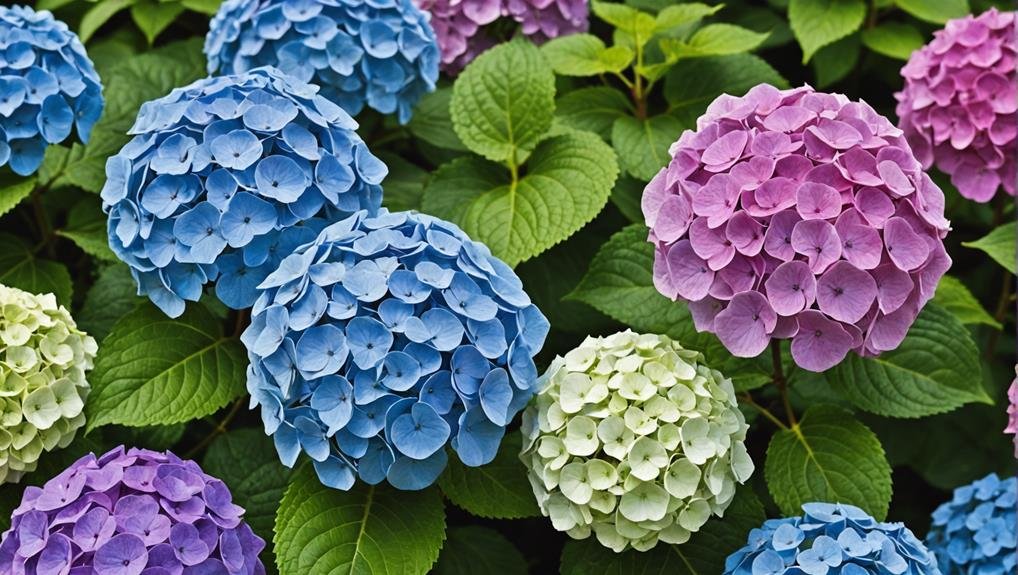
A diverse palette of color options, including pink, purple, blue, white, green, and red, makes hydrangeas an exceptionally versatile choice for wedding arrangements. Each hue brings a unique aesthetic and meaning, allowing couples to customize their floral decor to match their wedding theme and personal preferences.
Blue hydrangeas, known for their subtle and delicate tone, are ideal for creating an elegant and serene ambiance. They can seamlessly blend with other floral elements or stand alone for a striking centerpiece.
White hydrangeas symbolize purity and innocence, making them a timeless choice for weddings. Their classic and clean appearance can complement almost any color scheme, adding a touch of sophistication to bouquets and arrangements.
Green hydrangeas offer a unique blend of off-white-meets-green, providing a fresh and modern look. These blooms signify understanding and can add a natural, earthy feel to floral arrangements.
Beyond their aesthetic appeal, different hydrangea colors carry specific meanings, such as pink for genuine emotions and purple for gratitude. This variety makes hydrangeas adaptable for various wedding styles, from traditional to contemporary, ensuring they remain a popular choice among couples and florists alike.
Latin Name and Taxonomy
Beyond their alluring color varieties, the scientific classification of hydrangeas offers insights into their botanical characteristics and lineage. The Latin name for this popular wedding flower is Hydrangea macrophylla, which belongs to the family Hydrangeaceae. The genus Hydrangea encompasses over 70 species, including notable varieties such as Hydrangea paniculata and Hydrangea arborescens.
In terms of taxonomy, hydrangeas are classified as angiosperms, which are flowering plants that produce seeds enclosed within a fruit. They are further categorized as dicotyledonous, meaning they have two embryonic seed leaves or cotyledons. This classification is essential for understanding their growth patterns and plant structure. Hydrangeas typically feature simple leaves and produce clusters of flowers, which contribute to their popularity in floral arrangements.
The genus Hydrangea is exceptionally versatile, with species growing as shrubs, vines, or even small trees. This adaptability makes them a favorite for both landscaping and wedding floral designs. The large, showy flower heads of hydrangeas are composed of numerous smaller blooms, creating a stunning visual impact that is both elegant and timeless.
Geographical Origins
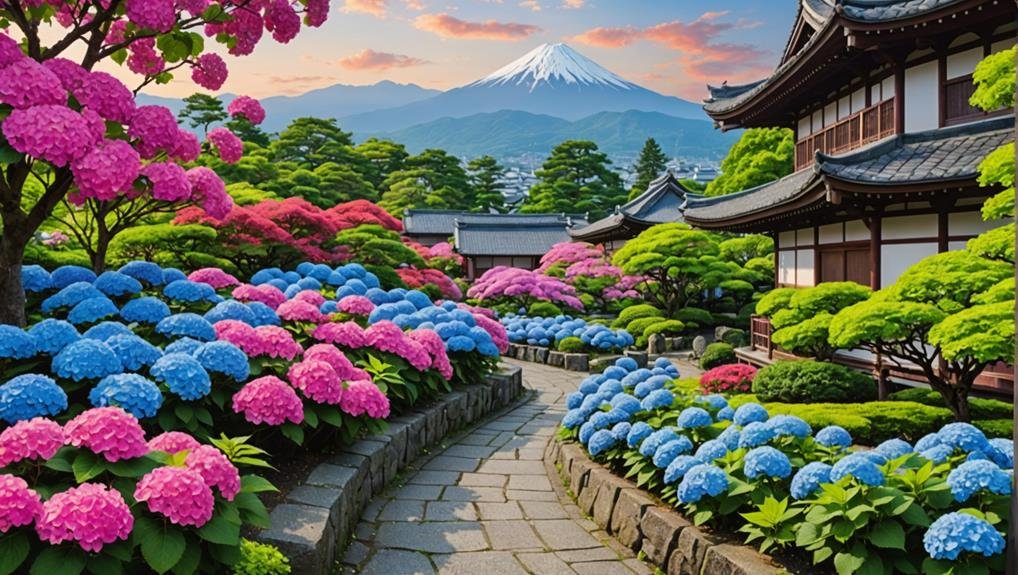
Hydrangeas originate from various regions in Asia, including Japan, China, and Korea, where they have been cultivated for centuries. These regions offer the temperate climates that hydrangeas thrive in, making them ideal for their growth and propagation. While native to Asia, hydrangeas have transcended their origins and become popular ornamental plants in gardens worldwide due to their adaptability and striking floral displays.
In Japan and China, hydrangeas are especially esteemed, often featured in traditional gardens and cultural ceremonies. Their versatility allows them to thrive in diverse geographical settings, from mountainous regions to coastal areas. This adaptability extends beyond Asia, as hydrangeas have also become common in North America, Europe, and parts of South America.
Different species of hydrangeas have specific geographical preferences. For instance, some varieties flourish in the higher altitudes of mountainous regions, while others are better suited to the milder climates of coastal areas. Despite these preferences, the plant’s ability to adapt to various soil types and climates has made it a favored choice for landscaping projects globally.
The global appreciation of hydrangeas underscores their versatility and enduring appeal, originating from their Asian roots and spreading to gardens around the world.
Season Availability
Seasonal presence of hydrangeas is an integral factor to keep in mind when planning floral arrangements for weddings. Generally, hydrangeas are accessible year-round, making them a flexible choice for Hydrangea Wedding Bouquets. However, their peak seasons are in spring and summer, when they are most abundant and vibrant.
It’s worth noting that the availability of different hydrangea varieties can vary slightly within these peak seasons. For instance, while many hydrangeas are readily accessible, specific colors like blue hydrangeas might be more seasonal or have limited availability. This is particularly true for blue and purple hues, which can be influenced by local climate conditions and soil pH levels.
Geographic location also plays an important role in the seasonal presence of hydrangeas. Regions with milder climates may have a more extended availability window, while areas with harsher weather conditions might see a shorter season.
To make sure that hydrangeas are accessible for your wedding date, it is essential to consult with florists or suppliers well in advance. They can provide precise information on the availability of specific hydrangea colors and varieties, helping you make informed decisions for your wedding floral arrangements.
Growing Conditions
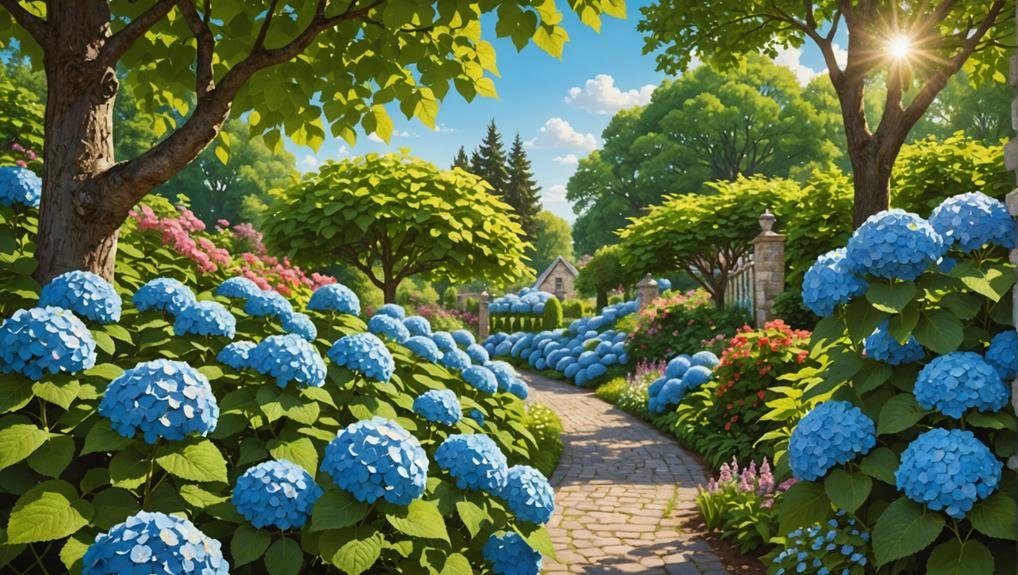
Understanding the growing conditions of hydrangeas is fundamental for promoting their best health and vibrant appearance in wedding arrangements. Hydrangeas thrive in well-draining soil and benefit from partial shade to full sun exposure. The ideal location offers morning sun with afternoon shade, especially in hotter climates, to prevent the flowers from wilting.
Consistent watering is essential for hydrangeas. The soil should be kept moist but not waterlogged, as excessive water can lead to root rot. Mulching around the plants helps retain moisture, regulate soil temperature, and suppress weeds, promoting a healthier growing environment.
Hydrangeas prefer acidic soil with a pH level between 5.2 and 5.5. Soil testing and amendments, such as adding sulfur or peat moss, can help achieve the necessary acidity. This ensures optimal growth and the vibrant colors desired for wedding flowers.
Pruning is a necessary practice for maintaining hydrangeas. It should be done after flowering to encourage new growth and maintain the plant’s shape. This not only enhances the overall appearance but also increases the production of blooms, making them ideal for use in wedding arrangements. Proper pruning techniques contribute to the longevity and beauty of these elegant flowers.
Cultural Significance
Throughout various cultures, hydrangeas hold a rich tapestry of symbolic meanings, making them a profound choice for wedding flowers. In Japanese culture, hydrangeas are often associated with gratitude and apology, serving as a means to express heartfelt emotions. This cultural significance can add a layer of depth to hydrangea bouquets on a wedding day, symbolizing sincere appreciation and the resolution of any past misunderstandings.
In Victorian times, however, hydrangeas carried a different connotation, representing vanity and boastfulness due to their large, showy blooms. While this symbolism might not be as vital today, it offers an intriguing historical perspective on the flower’s multifaceted meanings.
In Korea, hydrangeas are imbued with the qualities of understanding and patience, essential attributes for a harmonious marriage. This makes them particularly fitting for Korean weddings, where they convey important marital virtues.
Moreover, within the practice of Feng Shui, hydrangeas are believed to bring peace, harmony, and balance. This belief underscores their appeal beyond mere aesthetics, making them a thoughtful addition to wedding decor.
Across different cultures and traditions, the hydrangea’s versatile symbolism enhances its appeal, ensuring its enduring popularity in wedding celebrations.
Typical Use in Weddings
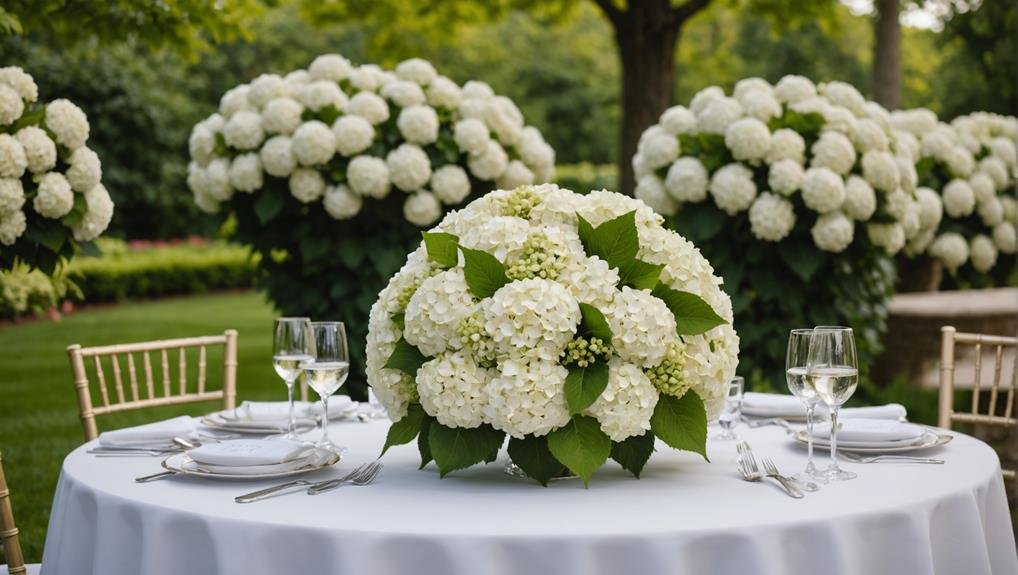
Given their rich symbolic meanings across cultures, hydrangeas are a favored choice for various elements of wedding decor. Their versatility and range of colors make them suitable for multiple uses in wedding arrangements.
Here are some common ways hydrangeas are integrated into wedding celebrations:
Hydrangea Bouquet:
Hydrangeas often serve as the focal point of bridal bouquets, adding volume and a touch of elegance. Their lush blooms can complement any wedding dress, from classic to contemporary styles.
Bridesmaid Bouquets:
Similar to the bridal bouquet, bridesmaid bouquets frequently feature hydrangeas. Their full, rounded shape provides a cohesive look that ties the bridal party together.
Ceremony Decor:
Hydrangeas are popular in ceremony decor, from altar arrangements to pew decorations. Their ability to fill space effectively makes them ideal for creating stunning visual backdrops.
Centerpieces:
For reception tables, hydrangeas are often used in centerpieces. Their robust size allows for fewer stems to create a significant impact, making them both a practical and beautiful choice.
Alternative Flower Types
While hydrangeas are a popular choice for wedding arrangements, incorporating alternative flower types like roses, peonies, and lisianthus can enhance the overall aesthetic and add variety to the decor.
Roses, with their timeless elegance, can complement the voluminous nature of hydrangeas, creating a balanced and sophisticated look. Peonies, known for their lush and full blooms, bring a touch of romance and softness, perfect for a dreamy wedding ambiance. Lisianthus, with its delicate and intricate petals, adds a refined elegance to any floral arrangement.
For those seeking unique blooms, consider integrating zinnias, jasmine vine, and southern hydrangea to introduce texture and visual interest. Additionally, mixing lilies, orchids, and tulips with cone hydrangeas can produce a dramatic and bold floral display, ideal for making a striking statement.
To achieve a traditional bouquet, pairing hydrangeas with garden roses, pink snowberry, and lace cap hydrangea can evoke a classic and timeless feel. For a personalized touch, embracing different textures and shapes with antique hydrangeas, mono-floral bouquets, and pastel hydrangeas can create a unique and memorable arrangement.
